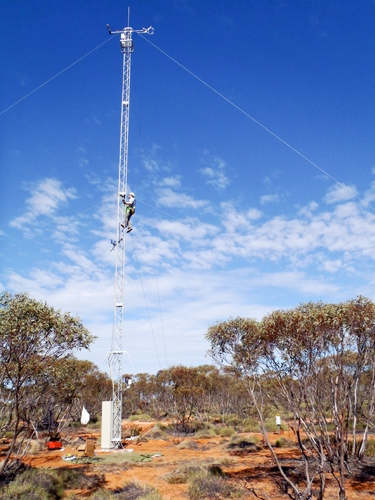At work at the OzFlux tower at the Chowilla site in South Australia …
one of 23 flux towers around Australia and New Zealand
Unprecedented opportunities for cross-disciplinary collaboration and integration are beginning to emerge as TERN moves from its construction phase into a phase of delivering critical research infrastructure for Australian ecosystem science. We explore here some of the ways in which the power of TERN’s nationally networked approach is already being realised in the context of carbon and water.
There is currently significant uncertainty about Australia’s net primary productivity – the difference between carbon that is taken up by vegetation from the atmosphere, and carbon respired by plants and microbes. There is corresponding uncertainty about rates of water loss through transpiration from plants and evaporation from soil and water bodies. This obviously limits our understanding of and capacity to manage interlinked carbon and water cycles.
The most effective way to directly measure exchanges of gases such as carbon dioxide and water vapour at the local ecosystem scale is via a flux tower. TERN’s OzFlux facility brings together 23 such towers across Australia and New Zealand, and involves researchers from 15 institutions. Each site typically measures exchanges of carbon and water between the ecosystem and the atmosphere using the eddy covariance technique, as well as other meteorological variables and structural and chemical characteristics describing the ecosystem. As the researchers are discovering, there are a number of advantages to being networked.
- OzFlux can provide a common set of measurements at multiple sites and time scales – these are available via the OzFlux portal.
- OzFlux can provide soft infrastructure that lessens the ‘costs’ to individual researchers associated with managing data generated by each tower.
- Sitting alongside and complementing the OzFlux facility are TERN’s AusCover, e-MAST and the Australian Supersite Network. These add significant value to what TERN can deliver. For example, the Australian Supersite Network is clustering other research infrastructure around flux towers. At each supersite, 1 ha monitoring plots provide information on the biodiversity and vegetation structure of the ecosystem whose gas exchanges are being measured by the flux tower. In time, it will become possible to connect patterns in fluxes measured by the tower with observed changes in standing biomass and carbon in the associated plots.
- Attempts to quantify ecosystem carbon and water fluxes, and their consequences for net primary productivity and carbon storage, can now expand from beyond the local scale to regional, ecosystem and continental scales.
CSIRO recently put OzFlux to work in research projects associated with a global initiative called RECCAP. Drawing on infrastructure and resources made available through other parts of TERN – the synthesis opportunities provided via ACEAS and remote-sensing products from AusCover – researchers sought to apply the new data pouring in through OzFlux to the problem of estimating Australia’s net primary productivity. They assimilated observations of carbon and water fluxes, stream-flow data from several hundred gauged catchments, litter-fall and carbon-pool data into a research version of the land-surface model CABLE (which is used in Australian global and regional climate modelling) in the BIOS2 modelling environment.
They found that the incorporation of the OzFlux tower data into the model significantly reduced uncertainty in estimates of continental-scale net primary production and evapotranspiration. In other words, while our capacity to understand Australia’s carbon and water cycles will be greatly improved by incorporation of multiple data streams into CABLE, direct measurement of the surface exchanges provides the most cost-effective way of improving model estimates. This work has been submitted for peer-review and publication – keep an eye on the TERN website for details.
The provision of flux data from OzFlux, especially when integrated with data streams from other TERN facilities and elsewhere, gives researchers a significant new capacity to begin to answer questions of enormous interest to managers and policy-makers concerned with Australia’s carbon and water cycles, such as:
- What is the annual carbon uptake by, and water loss from, the Australian continent?
- What is the ‘natural’ variation in these characteristics from year to year?
- What are the greatest sources of uncertainty in these estimates?
- How will climate change affect Australia’s carbon and water cycles?
Thanks to the multidisciplinary, networked infrastructure delivered through TERN, and the close collaboration between TERN and allied national research programs being undertaken in Australian research agencies (CSIRO, Bureau of Meteorology, universities, and Geosciences Australia), the answers to many such questions are within the reach of Australia’s ecosystem science community.
Published in TERN e-News July 2012







